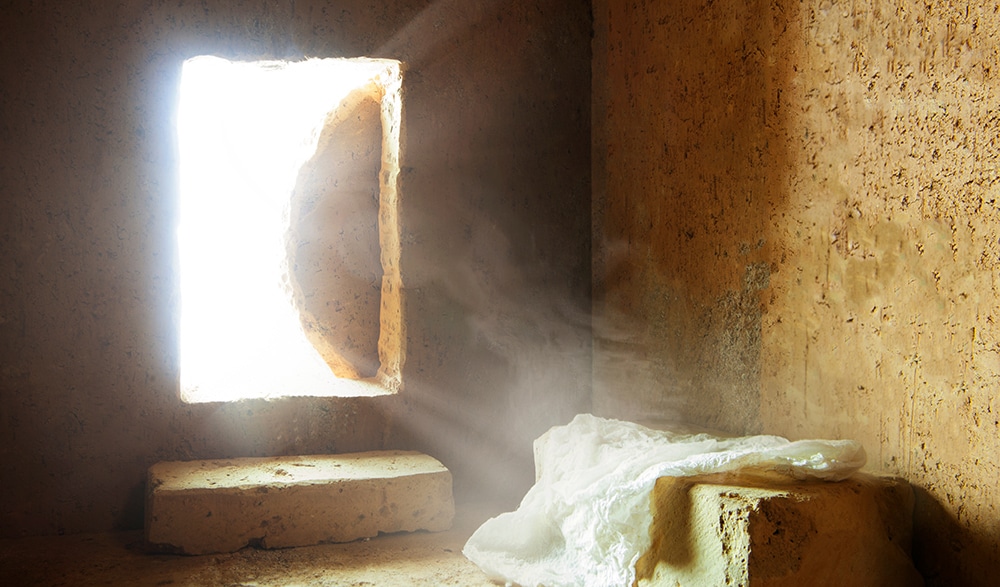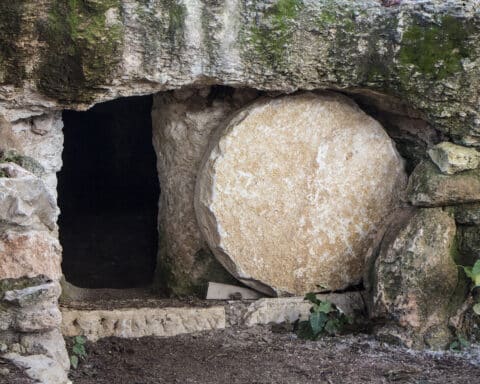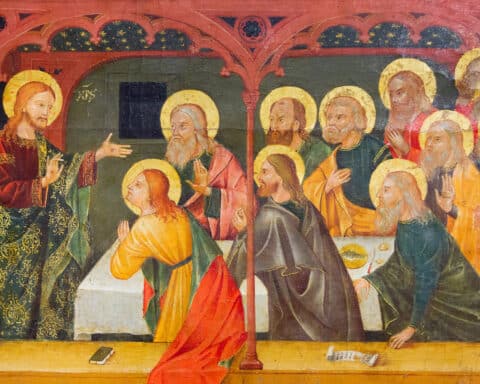“Then he said to Thomas, ‘Put your finger here and see my hands, and bring your hand and put it into my side, and do not be unbelieving, but believe.’ Thomas answered and said to him, ‘My Lord and my God!'” (Jn 20:27-28).
“For I know that after His resurrection also He was still possessed of flesh, and I believe that He is so now” (St. Ignatius of Antioch, Letter to the Smyrnaens).
For the past three decades, ever since attending Bible college as a young Evangelical Protestant, I’ve read and followed the work of several outstanding Evangelical and Anglican biblical scholars, including N.T. Wright, Craig Keener, Craig Evans, Ben Witherington III,, Michael Licona, Larry Hurtado and Richard Bauckham. In the course of writing my book “Did Jesus Really Rise from the Dead?” (Ignatius Press), I referred often to their works, as well as to the writings of some notable Evangelical philosophers and apologists, including William Lane Craig, Douglas Groothuis and Stephen T. Davis. While, of course, not always agreeing with everything they’ve written, I have always been deeply impressed with their rigorous scholarship, impressive knowledge and obvious love for Jesus Christ and truth.
I cannot express the same admiration for the thought and opinions of Serene Jones, current president of Union Theological Seminary, the oldest independent seminary in the U.S. and a well-known bastion of progressive and radical theology. Jones, who earned her doctorate in theology from Yale, was interviewed by the New York Times’ columnist Nicholas Kristof for a piece that appeared on Holy Saturday with the obligatory button-pushing title “Reverend, You Say the Virgin Birth Is ‘a Bizarre Claim’?”
While the Virgin Birth is discussed — and dismissed by Jones as “a bizarre claim” that “led to centuries of oppressing women” — the focus is mostly on the Christian belief in the bodily resurrection of Jesus Christ. The result is both revealing and embarrassing, a (thankfully) short and (unwittingly) educational demonstration of how progressive Christianity is intellectually bankrupt and bereft of any meaningful doctrinal heft or spiritual substance. In fact, Jones could well be mistaken for a condescending and shrill character in a Dan Brown novel, as when she insists:
“For me, the message of Easter is that love is stronger than life or death. That’s a much more awesome claim than that they put Jesus in the tomb and three days later he wasn’t there. For Christians for whom the physical resurrection becomes a sort of obsession, that seems to me to be a pretty wobbly faith. What if tomorrow someone found the body of Jesus still in the tomb? Would that then mean that Christianity was a lie? No, faith is stronger than that.”
Readers with some respect for logic will notice that Jones, first, relies on vague sentiments — “love is stronger than life or death” — while, secondly, mocking the traditional, orthodox belief of countless millions because someone might — just might! — find the body of Christ, even though many folks have sought — and failed — to find just that over the past two thousand years. Jones easily speaks of “faith,” but the object of her faith is ephemeral as her denunciations of orthodox Christian beliefs.
More to the point, belief in the physical resurrection is not something that has become an “obsession”; rather, right from the beginning, in Jerusalem, it has been the core of the Gospel and the heart of the Christian Faith. After all, when Peter, suddenly courageous and remarkably transformed, delivered his sermon on Pentecost, he did not waste time with greeting card slogans, but stated boldly words worth quoting at length:
“You who are Israelites, hear these words. Jesus the Nazorean was a man commended to you by God with mighty deeds, wonders and signs, which God worked through him in your midst, as you yourselves know. This man, delivered up by the set plan and foreknowledge of God, you killed, using lawless men to crucify him. But God raised him up, releasing him from the throes of death, because it was impossible for him to be held by it. For David says of him: ‘I saw the Lord ever before me, with him at my right hand I shall not be disturbed. Therefore my heart has been glad and my tongue has exulted; my flesh, too, will dwell in hope, because you will not abandon my soul to the netherworld, nor will you suffer your holy one to see corruption. You have made known to me the paths of life; you will fill me with joy in your presence.’ My brothers, one can confidently say to you about the patriarch David that he died and was buried, and his tomb is in our midst to this day. But since he was a prophet and knew that God had sworn an oath to him that he would set one of his descendants upon his throne, he foresaw and spoke of the resurrection of the Messiah, that neither was he abandoned to the netherworld nor did his flesh see corruption. God raised this Jesus; of this we are all witnesses.” (Acts 2:22-32)
This emphasis on the bodily resurrection was repeated again and again by Peter and the other apostles, and later by Paul, who took this startling news to Athens, where many mocked him after he proclaimed that Jesus Christ had risen from the dead (Acts 17:30-32). Of course, any Christian possessing the most rudimentary knowledge of Scripture is familiar with the famous story of doubting Thomas, who touched the wounds of Christ and then cries out, “My Lord and my God!” (Jn 20:24-30). The point here is quite simple but fundamental: The first Christians were not transformed by preaching, or moral exhortations, or fuzzy feelings, but by witness and testimony that Jesus Christ, who had died on the cross, was alive and well, with a glorified, physical body. This is why, for instance, Judas’ replacement had to be a man who had been with Christ during his public ministry so that, as Peter stated, that new apostle could “become with us a witness to his resurrection” (Acts 1:22).
Jones surely knows this. And surely she must know that the idea of a purely spiritual resurrection, as I discuss at length in my book, is a concept completely foreign to the Jews of Jesus’ day. As N.T. Wright and others have demonstrated, for first-century Jews the concept of resurrection referred to what happened to the body, not to the spirit. A spiritual resurrection, if by that one means a resurrection involving no kind of body, would have been regarded as a contradiction in terms — as pure nonsense. As I write, in discussing 1 Corinthians 15, where Paul reflects in detail on the meaning and nature of the Resurrection:
“If Paul and the early Christians wanted only to say that Jesus continued to exist after death as a spirit, it is hard to understand why they would use the term resurrection, which would be interpreted as referring to a bodily transformation, rather than a transformation into a spirit. The language of spiritual immortality was common in Judaism of the time. The early Christians knew the difference between a spirit and a ‘spiritual’ or resurrected body, as seen in Luke 24:39, in which Jesus says, ‘[F]or a spirit does not have flesh and bones as you see that I have.'”
Further, the early Christians were not gnostic; that is, they did not spurn the material realm and denounce the body as evil or unnecessary. They certainly would have found Jones’ further description of belief in the Resurrection as “adherence to rigid dogma” to be both befuddling and nonsensical. As Jesuit Father Brian E. Daley, explains in his exceptional study “The Hope of the Early Church: A Handbook of Patristic Eschatology” (Baker Academic), the early Christians stood firm in their belief that there will be a bodily resurrection, befitting God’s direct activity — through creation and the Incarnation — in the material world. Hope in this bodily resurrection is found, for example, in the writings of Irenaeus of Lyons, who defended Christian belief from Gnostic attacks in the second century. “Hope in such a resurrection is an integral part of the Christian tradition of faith Irenaeus is concerned to protect,” writes Daley. “Irenaeus insists on the fleshly reality of risen bodies: only such a hope can take seriously God’s involvement with his creation … .”
One hardly expects an academic treatise in a newspaper interview, but Jones is so beholden to the fashionable rhetoric of the present age (she is an ardent supporter of “LGBTQIA+ people” who opposes “patriarchal God-talk which oppresses women”) that she struggles to present a compelling theological argument. She denounces belief in the Virgin Birth because it allegedly inspires a theology “in which sexuality is considered sinful,” and then dismisses belief in the resurrection of the body, as though it is impossible to have a positive view of creation, a high regard for the rightful place of sex, and a profound belief in the supernatural end of both.
In contrast, her views are more than a little gnostic, as she conveniently selects concepts and information in order to promote beliefs that owe far more to John Shelby Spong than to St. John the Evangelist. So, for instance, she apparently accepts the Gospel accounts of the crucifixion, but then dismisses the accounts of those same Gospels relating what the first Christians experienced and believed. And on what basis? Some sort of special knowledge, or gnosis?
Apparently so, for she concludes the interview by stating, “I often feel like we are in the middle of another reformation in a 500-year cycle.” Very much like Spong (who wrote a dreary book titled “Why Christianity Must Change or Die”), she insists that “Christianity is at something of a turning point. We need a new way entirely to think about what it means to be a human being and what the purpose of our lives is. For me, this moment feels apocalyptic, as if something new is struggling to be born.” In short, she rejects Christianity almost entirely, and wishes to proclaim it with something “new” while emptying it of its very heart and substance — much like the authors of the so-called “gnostic gospels.”
History, in fact, is littered with the remains of esoteric and heretical attempts to remake, remold, restore, rebirth, rethink and otherwise remodel Christianity. In my book, I discuss the views of Spong, Deepak Chopra, liberal Protestants, and others who have pursued such projects, all of them marked with chronological snobbery and deeply averse to the scandal of particularity found in the Gospels and proclaimed by the Church for all these many centuries. Jones’ theology is cut from the same thin cloth — what Romano Guardini referred to as “very thin ethics and piety” in his book “The Lord” — which disintegrates in the face of authentic dogmas, which are “are lights along the path of faith” (Catechism of the Catholic Church, No. 89).
She would do well to harken to the words of a Protestant theologian she often mentions, apparently in admiration — John Calvin:
“The mortal body which he had formerly carried he again received; for it would not have availed us much if a new body had been substituted, and that which had been offered in expiatory sacrifice been destroyed. We must, therefore, attend to that connection which the Apostle celebrates, that we rise because Christ rose (1 Cor. 15:12); nothing being less probable than that the flesh in which we bear about the dying of Christ, shall have no share in the resurrection of Christ” (Institutes of the Christian Religion).
Carl E. Olson is the editor of Catholic World Report.





